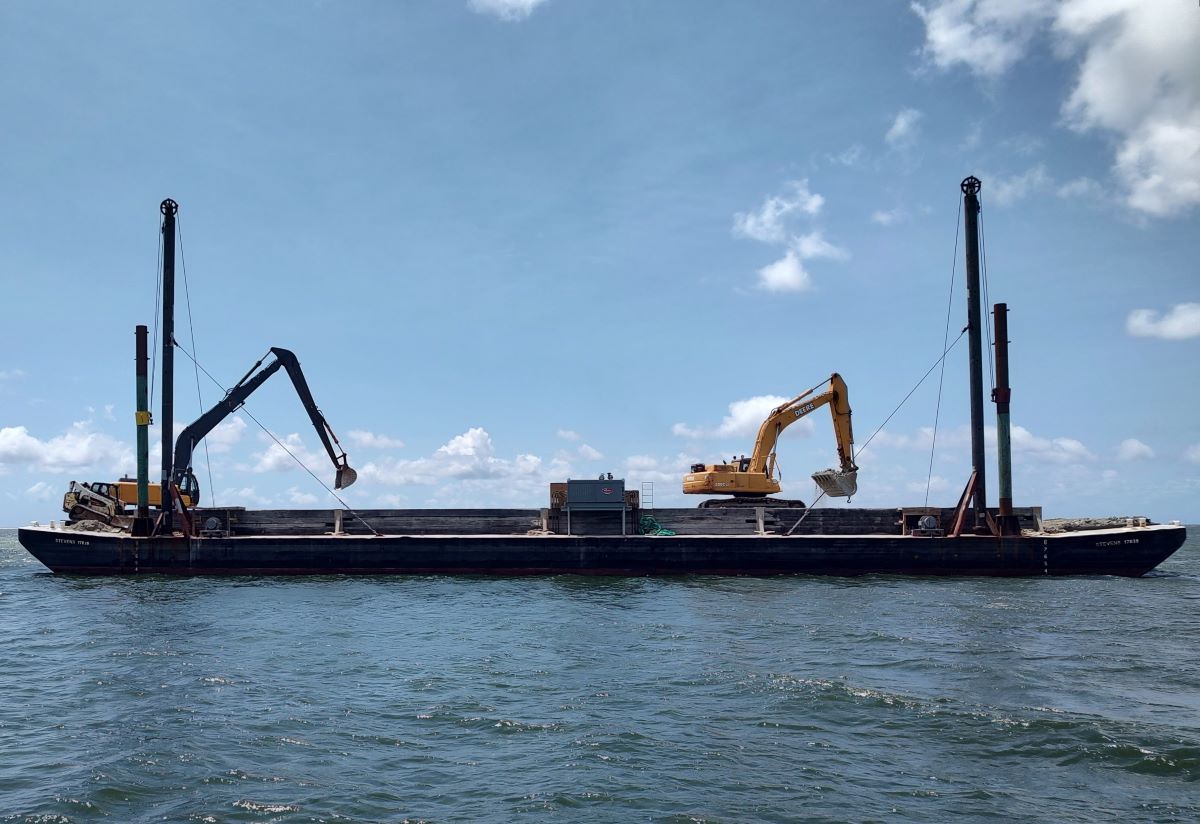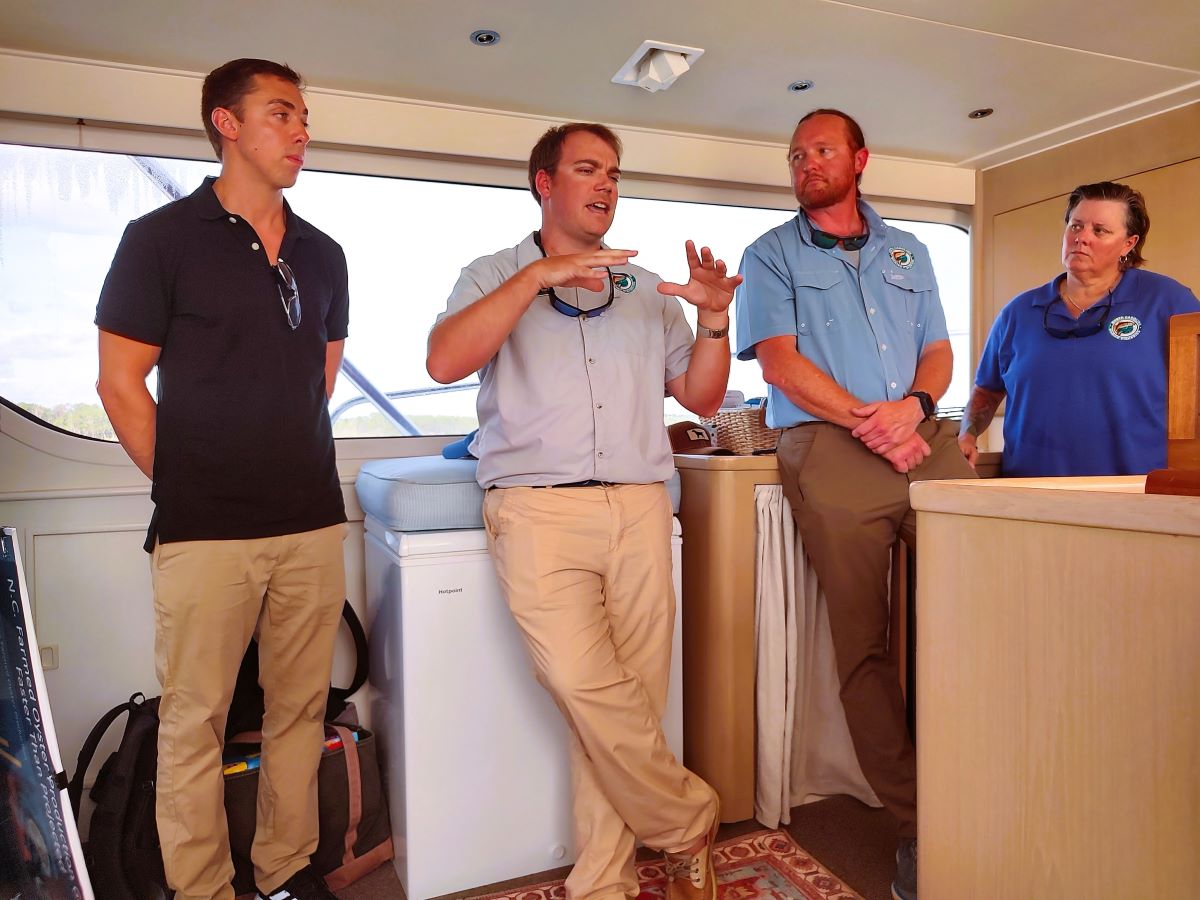
In Pamlico Sound early Tuesday afternoon, near Cedar Island National Wildlife Refuge in Down East Carteret County, two excavators at each end of a barge strategically placed the day’s load of 700 tons of limestone marl and crushed concrete into the water.
They are building the new Cedar Island Oyster Sanctuary. The three-phase project, currently in phase 2, is the most recent for the North Carolina Coastal Federation and the state Division of Marine Fisheries to build up the oyster population in Pamlico Sound. The Coastal Federation publishes Coastal Review.
Supporter Spotlight
The nonprofit organization and the state agency, along with contractor Stevens Towing, which has an office in North Carolina, have partnered since 2009 to build about 110 acres of oyster sanctuaries, which are large-scale oyster restoration reefs that provide oyster larvae that reseed the wild population and cultch-planted areas.
A handful of division officials, federation staff, members of the media and Sen. Norm Sanderson, R-Pamlico, rode out Tuesday to the Cedar Island Oyster Sanctuary construction site to see how the material is deployed to create what looks like ridges underwater for oysters to grow on and spawn.
This was the first trip for Sanderson to see how the sanctuaries are built.
“It’s pretty awesome,” he told Coastal Review on the ride back to South River, “to be that close and see how simple it is but how affective it is.”
He said initiatives like the oyster sanctuaries are important to him because he has a heart for commercial fishermen, and always has.
Supporter Spotlight
“I know that they’re in a bad place right now, and I don’t see this industry as something that can save them, but we can help give them options,” he said, adding this work benefits not only the fishing industry, but also the environment and the state’s economy and tourism. “There’s just a lot of positives about it.”
Expected to be about 75 acres once complete, the Cedar Island sanctuary is the newest in the Sen. Jean Preston Oyster Sanctuary Network in Pamlico Sound.
Now in its fourth edition, the “Oyster Restoration and Protection Plan for North Carolina: A Blueprint for Action,” which details strategies for oyster protection, restoration, harvest and education, set a goal in 2008 for 500 acres of protected sanctuary by 2025 in the network named after the senator from Carteret County who died in 2013. To date, there are 15 sanctuaries, according to the division, with Cedar Island being the newest and will contribute to the 500-acre goal.
The division’s sanctuary biologist, Bennett Paradis, told the group on the way to the site that division staff had been busy all summer checking progress. A crew dives the sanctuaries and brings material up to the boat. Then, they count and measure oyster density to get an idea of what the population structure looks like. The larger oysters are older, and if there’s a lot of larger oysters, then he said they know it’s a thriving population.
Erin Fleckenstein, coastal scientist with the Coastal Federation, said during the trip out to the site that researchers have found that the oyster sanctuaries are successful. The sanctuaries make up 6% of all the potential oyster reef in Pamlico Sound and contribute 20% of the population. “It’s only a 6% footprint, but it’s 20% of the whole population, and then they’re contributing 25% of all the oyster babies that are floating around in the sound.”
Federation Executive Director Todd Miller told Coastal Review that the science shows that the sanctuary plays a vital role in sustaining healthy oyster populations in the sound and the coastal economy.
“This large construction project employs local marine contractors, barge operators, truck drivers, boat crews, and rock miners — and is an important economic driver in eastern North Carolina both during construction but also in sustaining our marine fisheries and tourism economies,” Miller said, adding that the National Oceanic and Atmospheric Association and the North Carolina General Assembly support the project.
Jordan Byrum is the division’s artificial reef program coordinator who oversees the oyster sanctuary program.
He said during a brief presentation while heading to the sanctuary site that earlier this year, 18,000 tons of rock was stockpiled at the division’s South River site and about a third of it is left to be deployed for this phase. There have been between 20 and 25 deployments so far this year.
About 20 acres of the Cedar Island sanctuary were completed last summer during the first phase. For Phase 2 this year, contractors have been moving material since spring from a division site in South River to the sanctuary. The same progress is expected this year, around 20 acres, totaling around 40 to 45 acres completed. He said that he expects the Cedar Island sanctuary to take another year or year and a half to be complete.
“We should wrap up year two at Cedar Island in a couple more weeks,” Byrum said in a follow-up email Friday. “That will bring us up to about 320 acres of habitat in oyster sanctuaries.”

All the limestone marl and granite for this project was purchased from North Carolina companies, Byrum said. The material is trucked to staging sites by a Vanceboro towing company, including the site in South River where Stevens Towing collects material for the Cedar Island sanctuary.
Byrum explained to the group Tuesday that the Coastal Federation had applied for a NOAA grant that would help meet the goal of 500 acres of protected oyster sanctuary in Pamlico Sound. “We’ve put together a plan to basically create two new sanctuaries,” he said, as well as finish out some of the undeveloped areas on a handful of other sanctuaries, with the ultimate goal to meet the 500 acres of oyster sanctuary.
After next year, then three more years of construction, they’ll meet the 500 acres of sanctuary goal, Byrum said.
To put that in perspective, he said, this year 18,000 tons of rock was used. Over the next three years, the plan is to use about 60,000 tons each year, for a total of 180,000.
NOAA began supporting the Coastal Federation’s large-scale oyster sanctuary work in 2009 with a $5 million American Recovery and Reinvestment Act grant and has provided more than $12 million since for oyster restoration efforts in the state, Christine Van Dyck, federation assistant director, told Coastal Review.
The federal agency also contributed funding to the North Carolina Oyster Blueprint, monitoring by N.C. State University’s Center for Marine Sciences and Technology, or CMAST, and adaptive management by the project team of the federation, Division of Marine Fisheries, the contractors and the researchers, Van Dyck said.
“We are currently on year two of our most recent NOAA partnership, and are applying to their Transformational Habitat Restoration and Coastal Resilience Grants this fall,“ in partnership with the division and CMAST for $15 million to complete the 500-acre Jean Preston Oyster Sanctuary in Pamlico Sound, Van Dyck said.
The state has provided millions in matching funds through the partnership, she added.








